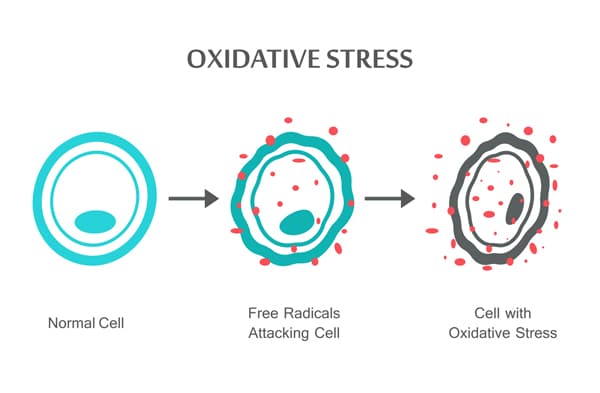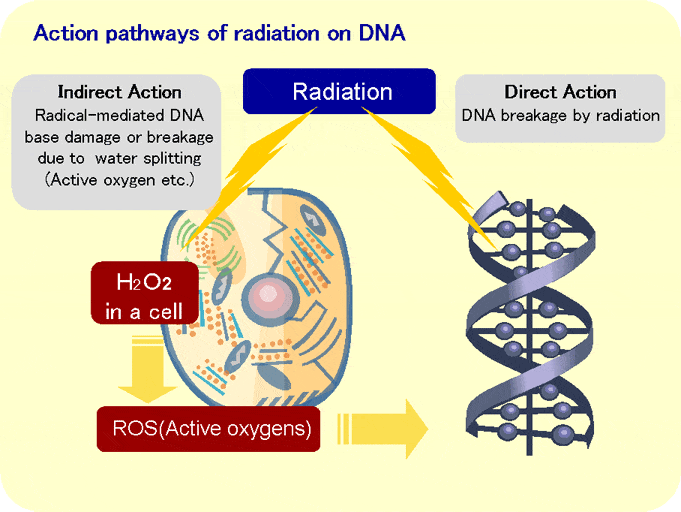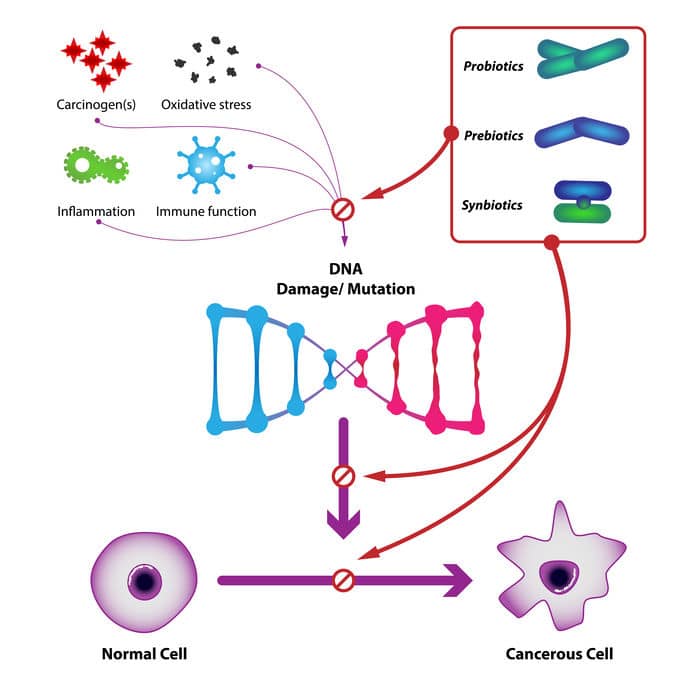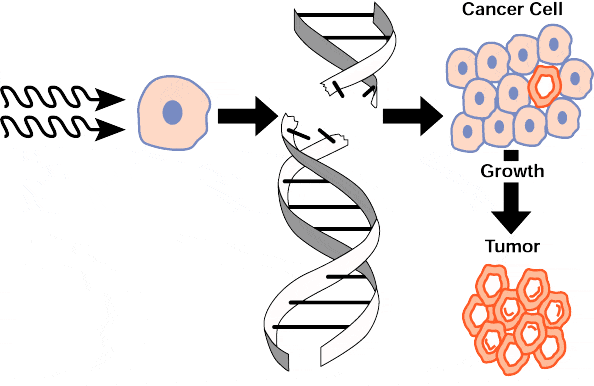Your cart is currently empty!

How EMFs Biologically Impact the Body’s Cells and Damage DNA
Last Updated on February 20, 2024

You can’t see it –
It’s electric!
You gotta feel it –
It’s electric!
Just like in the popular song, the human body is controlled by a series of electrical impulses sent out by the brain.
This enables your body’s cells to communicate, through an elaborate network of nerve endings, synapses and junctions.
Researchers have found that this bioelectrical communication steers growth and development. Small interferences in this communication from outside sources can have a butterfly effect in your body. This can lead to reversible and irreversible biological changes in certain cells and processes.
Electromagnetic Field radiation (EMF) is emitted from your cell phone and all electronic devices, and as such, it can disrupt cells. But how serious is this disruption, and what effects can be seen from it?
This bioelectrical interference, as well as other concerns (e.g. correlation between cancer and power lines) has led to many types of research on just exactly what kind of harmful effects EMFs from electronic devices have on the cells in our bodies.
Cellular Stress Response and DNA Fragmentation
A cell is built to protect the DNA, RNA, and protein macromolecules inside it.
However, every cell experiences threats, in the form of both intrinsic conflicts and external oxidants, toxins, and heat. These can compromise the integrity of its genome and proteome. When this happens, the cell can go into a cellular stress response, which is a big domino effect!
In August 2009, a paper by Columbia University described how EMFs activate a cellular stress response. EMFs can penetrate a cell’s nucleus and interact with its DNA, bypassing a cell’s defense mechanisms.
The Process
According to studies, they can do this by generating reactive oxygen species (ROS) upon entrance into the cell. ROS are not bad, and are involved in many different cellular functions. However, too much ROS can become toxic to maintaining homeostasis in the cell by changing enzyme activity and gene expression (which is linked to many diseases). It is also responsible for peroxidation of membrane phospholipids. The cell has anti-oxidative mechanisms that can alleviate the damage caused by ROS and protect the cell membrane.
However, EMFs cause an overproduction of ROS, which impairs these defense mechanisms and creates excessive free radicals, or oxidants. Excessive amounts can lead to cancers, necrosis (neuron death) and neuronal damage in brain tissue, as well as neurological disorders like Alzheimer’s, spinal injury, multiple sclerosis, and epilepsy. Since the brain has such a high metabolic rate, ROS and oxidative damage can happen easier than in other organs.

Long story short, EMFs create an imbalance between ROS and antioxidants to get through the membrane into the nucleus. It interacts with and causes specific breaks in DNA strands, and this results in oxidative stress and a cellular stress response.
Oxidative stress in a cell causes expression of stress response genes, called HSP70, and increases levels of stress proteins, called hsp70.
All living things generate stress proteins to survive environmental stressors. At first, it was thought that only “heat shock” could cause a cellular stress response, hence why the stress response proteins are called hsp (heat shock proteins). However, many other stimuli, like pH, osmotic pressure changes, alcohol, toxic metal ions, and EMFs were discovered to activate hsp synthesis. EMF induction of increased levels of hsp70 happens within five minutes, and can happen at levels of energy input 14 times lower than the energy needed to create a thermal response.
These stress proteins help chaperone the cells, and repair and refold damaged proteins by transporting them across membranes. This synthesis is an adaptation of cellular stress proteins before preparing the cell for an appropriate environmental change, which will influence overall stress tolerance.
How EMFs Cause Oxidative Damage in a Cell:
- EMFs enter cell
- Reactive Oxygen Species (ROS) are generated
- Anti-oxidative mechanisms try to regulate ROS and protect the cell membrane
- Too much ROS is generated, which impairs anti-oxidative mechanisms (can lead to many other diseases)
- Membrane is compromise, EMFs can now enter cell nucleus
- EMFs break DNA strands, which damages cell (and can lead to cancerous tumors)
- Stress response increases hsp stress proteins

A paper by Professor Tom Butler from University College Cork in Ireland claimed that: “there is substantial evidence that oxidative damage to cellular proteins, lipids and DNA is at the root cause of many of the ill-effects of microwave RFR.”
In addition, a research paper states: “Oxidative damage to cellular DNA can lead to mutations and may, therefore, play an important role in the initiation and progression of multistage carcinogenesis…Elevated levels of ROS and down regulation of ROS scavengers and antioxidant enzymes are associated with various human diseases including various cancers. ROS are also implicated in diabetes and neurodegenerative diseases.”
The authors of the Columbia University paper concluded that for the protection of living cells, EMF safety limits must be changed from their current standard, which presently only specify protection against thermal effects.

EMFs and VGCCs
Another effect of EMFs interaction with our cells is the increase of calcium ions in our cells. More than 20 years ago, a study found that EMF exposure could produce changes in calcium signaling in the membranes surrounding each of our cells.
Twenty‐three different studies since then have found that EMFs activate a voltage sensor in the cell membrane that controls calcium channel signaling. These calcium channels are called VGCCs, or voltage-gated calcium channels.
It is voltage-gated because EMFs can force the voltage sensor (which detects electrical changes) to open the gate to the cell membrane, immediately allowing a ton of calcium ions, called intracellular Ca2+, into the cells. The sensor is extraordinarily sensitive to the electrical forces from EMFs, which are about 7 million times stronger than the forces on singly-charged groups elsewhere in the cell.
Why is extra intracellular calcium bad?
It may lead to multiple regulatory responses, including increased nitric oxide levels (NO) and superoxide levels.
Why is this bad?
Well, nitric oxide has some beneficial health effects, like stimulating bone growth coupled with increased calcium. But too much of it will make it react with superoxide to form peroxynitrite. This is a big-time potent non-radical oxidant, which breaks down to form many different free radicals. Excessive free radicals, as we know, create oxidative and nitrosative stress, which can damage the cell and lead to many chronic diseases.
Autism has been connected with excessive amounts of intercellular calcium. Many studies have predicted that the correlation between EMF exposure and Autism could be due to the increased calcium signaling pathways EMFs cause.
While these EMFs are weak, the amount of electrical force they put on the highly-sensitive voltage sensor causes a vast increase of calcium ions in the cell, which can lead to many impactful biological changes. This happens in humans, animals, and plant cells as a universal mechanism.
Martin Pall, Ph.D., is the chief proponent behind the research showing VGCC activation by EMFs is related to many different biological effects. In fact, he argues that almost all biological effects are because of this process. From his research and research of others, he has compiled many different biological effects that he argues are caused directly by VGCC activation, listed below as he wrote them in a letter to the FCC.
VGCC Activation Effects due to EMF Exposure:
- “Various neurological/neuropsychiatric effects, including changes in brain structure and
function, changes in various types of psychological responses and changes in behavior. - At least 8 different endocrine (hormonal) effects.
- Cardiac effects influencing the electrical control of the heart, including changes in
ECGs, producing arrhythmias, changes that can be life threatening. - Chromosome breaks and other changes in chromosome structure.
- Histological changes in the testes.
- Cell death (what is now called apoptosis, a process important in neurodegenerative
diseases). - Lowered male fertility including lowered sperm quality and function and also lowered
female fertility (less studied). - Oxidative stress.
- Changes in calcium fluxes and calcium signaling.
- Cellular DNA damage including single strand breaks and double strand breaks in
cellular DNA and also 8-OHdG in cellular DNA. - Cancer which is likely to involve these DNA changes but also increased rates of
tumor promotion-like events. - Therapeutic effects including stimulation of bone growth.
- Cataract formation (previously thought to be thermal, now known not to be).
- Breakdown of the blood-brain barrier.
- Melatonin depletion and sleep disruption.”
Other Impacts on the Cell
A Hungarian study in 2000 showed cellular responses to various forms of radiation, including EMFs. Several reversible alterations occurred in the structure of cell organelles. Many permanent changes, including morphological signals associated with cell death, were also triggered.
In 2005, an Italian independent paper corroborated the Hungarian findings. Non-thermal EMF in the cell phone frequency was shown to induce apoptosis or programmed cell death in human recombinant cells. In the paper, signs of radiation-induced damage included changes in the organization of the cell membranes. Perturbations in the composition of the cell or different membrane domains, including enzymes and binding sites.
Virtually every important sub-unit, including the mitochondria, endoplasmic reticulum, Golgi complex, and lysosome system were affected in some way by EMF exposure. Morphological changes in the appearance of the cell, as viewed through electron microscope, revealed chromosomal aberrations. It is believed that this is the result of radiation causing DNA or damage to proteins in the nucleus or “brain” of the cell. Counter arguments were given that the damage done was not permanent and only part of a stress response.
Why Does All This Matter?
Our bodies are not without defense mechanisms. If our body experiences a small amount of damage, we can usually cope. Occasional breaks in DNA are actually normal and can happen through routine exposure to the environment, such as from UV radiation from the sun.
However, if we receive too much damage, it may become difficult for our body’s defenses to cope with overwhelming problems. Thus, permanent changes to a cell which goes unfixed can lead to many diseases, including cancer.
According to the CDC, studies have shown that “workers exposed to high [electromagnetic] fields have increased cancer rates.”
In the case of cancer, a damaged cell is not fixed or destroyed, instead it proliferates out of control and becomes a tumor or growth.

EMF is suggested as a contributing factor in disrupting normal bioelectrical synchronization, which aggravates Autism Spectrum conditions.
Because the human body is a delicate electrical machine made of millions of cells, small perturbations through the dangers of cell phones and other EMF exposure can have harmful consequences down the road. More correlation studies undoubtedly will be done as EMFs take more and more of a central position in our lives.
How to Stay Safe
While the jury is still out, it is extremely important to play it safe and defend yourself from unnecessary EMF radiation exposure. You should stay mindful of any toxin or stressor that creates excessive oxidative stress, since it can lead to a host of biological problems.
In 2009, the European Environment Agency put out a review entitled “Late Lessons from Early Warnings: Towards realism and precaution with EMF?” In the paper, the public is urged to help participate in risk analysis as our scientific body of knowledge on EMF is still growing. As the paper title would imply, it is important to take reasonable precautions, where lack of conclusive information is still being found.
Below are some easy things you can do to lessen the impact EMF radiation has on your body and cells:
- Create some distance between you and your phone or other device when possible. Set your phone to Airplane mode when not in use, since doing so cuts off wireless transmissions and radiation.
- Limit the time you use your phone and when you do, use speakerphone or radiation-free air tube headphones when you make calls.
- Turn off Bluetooth and WiFi on your devices whenever possible, and instead think of using a wired connection or an Ethernet cable when you do need to connect to other devices or the Internet.
- When you are actively using your device, consider using a cell phone EMF shield to help guard yourself from EMF radiation when you are actively using your device.
Learn More About the Biological Effects of EMF Radiation
Related Posts
None found



























